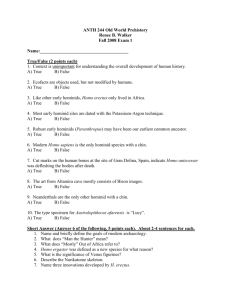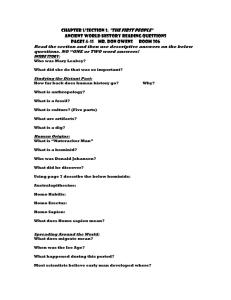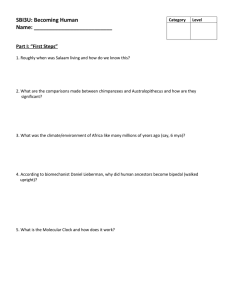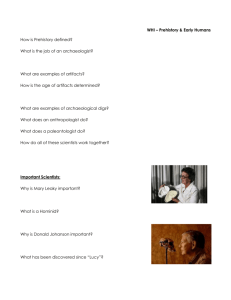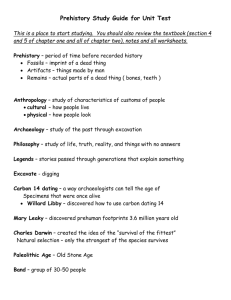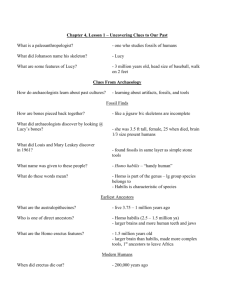All Early Human Notes
advertisement
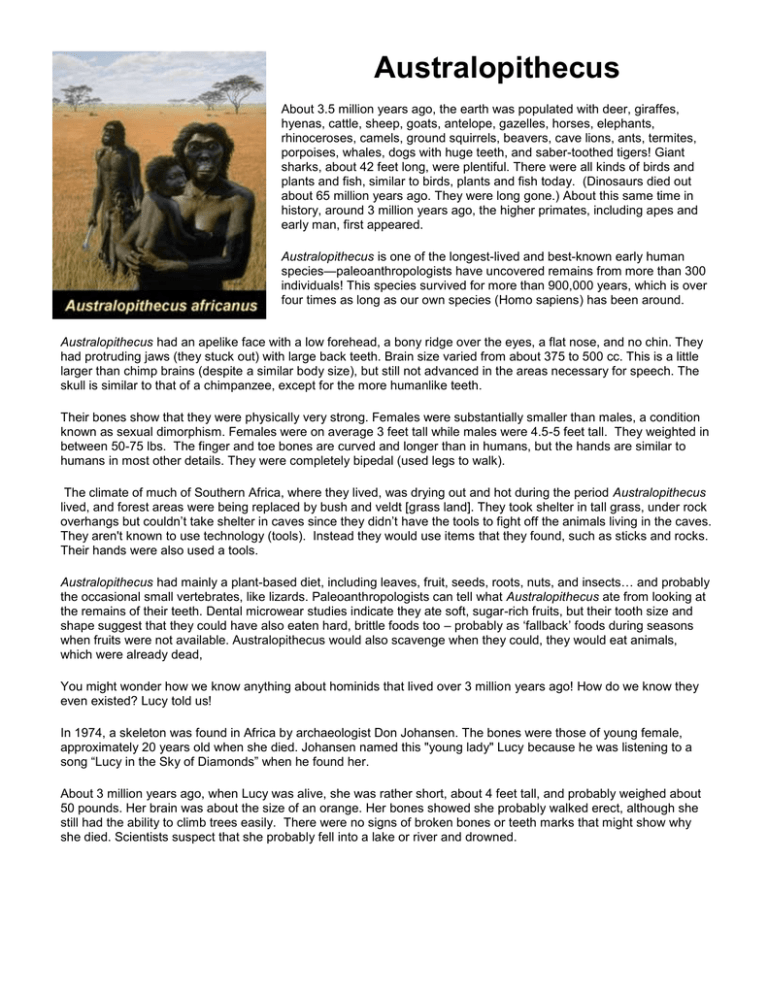
Australopithecus About 3.5 million years ago, the earth was populated with deer, giraffes, hyenas, cattle, sheep, goats, antelope, gazelles, horses, elephants, rhinoceroses, camels, ground squirrels, beavers, cave lions, ants, termites, porpoises, whales, dogs with huge teeth, and saber-toothed tigers! Giant sharks, about 42 feet long, were plentiful. There were all kinds of birds and plants and fish, similar to birds, plants and fish today. (Dinosaurs died out about 65 million years ago. They were long gone.) About this same time in history, around 3 million years ago, the higher primates, including apes and early man, first appeared. Australopithecus is one of the longest-lived and best-known early human species—paleoanthropologists have uncovered remains from more than 300 individuals! This species survived for more than 900,000 years, which is over four times as long as our own species (Homo sapiens) has been around. Australopithecus had an apelike face with a low forehead, a bony ridge over the eyes, a flat nose, and no chin. They had protruding jaws (they stuck out) with large back teeth. Brain size varied from about 375 to 500 cc. This is a little larger than chimp brains (despite a similar body size), but still not advanced in the areas necessary for speech. The skull is similar to that of a chimpanzee, except for the more humanlike teeth. Their bones show that they were physically very strong. Females were substantially smaller than males, a condition known as sexual dimorphism. Females were on average 3 feet tall while males were 4.5-5 feet tall. They weighted in between 50-75 lbs. The finger and toe bones are curved and longer than in humans, but the hands are similar to humans in most other details. They were completely bipedal (used legs to walk). The climate of much of Southern Africa, where they lived, was drying out and hot during the period Australopithecus lived, and forest areas were being replaced by bush and veldt [grass land]. They took shelter in tall grass, under rock overhangs but couldn’t take shelter in caves since they didn’t have the tools to fight off the animals living in the caves. They aren't known to use technology (tools). Instead they would use items that they found, such as sticks and rocks. Their hands were also used a tools. Australopithecus had mainly a plant-based diet, including leaves, fruit, seeds, roots, nuts, and insects… and probably the occasional small vertebrates, like lizards. Paleoanthropologists can tell what Australopithecus ate from looking at the remains of their teeth. Dental microwear studies indicate they ate soft, sugar-rich fruits, but their tooth size and shape suggest that they could have also eaten hard, brittle foods too – probably as ‘fallback’ foods during seasons when fruits were not available. Australopithecus would also scavenge when they could, they would eat animals, which were already dead, You might wonder how we know anything about hominids that lived over 3 million years ago! How do we know they even existed? Lucy told us! In 1974, a skeleton was found in Africa by archaeologist Don Johansen. The bones were those of young female, approximately 20 years old when she died. Johansen named this "young lady" Lucy because he was listening to a song “Lucy in the Sky of Diamonds” when he found her. About 3 million years ago, when Lucy was alive, she was rather short, about 4 feet tall, and probably weighed about 50 pounds. Her brain was about the size of an orange. Her bones showed she probably walked erect, although she still had the ability to climb trees easily. There were no signs of broken bones or teeth marks that might show why she died. Scientists suspect that she probably fell into a lake or river and drowned. Homo habilis Homo habilis are considered to be the first true humans who lived from about 2.5 to 1.8 million years ago and inhabited the southern and eastern parts of Africa. The climate was hot and dry. Homo habilis is the earliest known species to show novel differences from the chimpanzee and australopithecine skulls. The face is still primative and projecting, but the jaw is pulled under the brain, with smaller molars (though still much larger than in modern humans), and the skull is thinner, with a distinctive rounded shape, vertical sides and a small forehead above the brows. In addition, Homo habilis had a fairly apelike physical form: its arms were almost as long as its legs. Homo habilis may have stood at around 3 - 5.5 feet tall and weighed less than modern humans. Their jaws were much larger than ours. The two signature evolutionary trends in hominids are increasing brain size. Their brain sized averaged about 650cc800cc, ½ the size of modern man. They also had a proportionate reduction in the size of the face. In Homo habilis, the brain shape is more humanlike: the bulge of Broca's area, implicated in human language, is visible in at least one Habilis brain cast. Because Homo habilis was had an increase in brainpower, they are the first known group to make tools out of sharpened stone, bone and quartz. Habilis was given the nickname “Handy Man” because of his efficient use of tools. He is associated with the Oldowan tool industry, which is characterized by crude stone flakes, rounded hammer stones, and bones used for digging. Homo habilis is not the first hunter. Odd stones and pieces of bone may have been used as weapons or scrapers much earlier in time. Tools now begin to show up regularly near dismembered animal remains such as mice and squirrels. One interpretation of the evidence is that Homo habilis scavenged dead prey killed by other animals, and used sharpened stones, bones or wood to extract the marrow from bones too large for carnivores to break. They also used the sharpened tools to scrape hide off of animals. Although this group made stone tools and weapons, these tools and weapons were still pretty basic. Homo habilis may have moved together in larger groups for protection and efficiency. They followed food sources, and set up camp as needed. Whenever possible, they found shelter under cliffs and around trees making shelters from sticks. You might think they would look for caves to spend the night, but caves quite often had dangerous occupants, just as they do today. Their main diet probably consisted of fruits, roots, nuts and vegetables that they found growing wild. However, they were Omnivores so they also killed small animals and/or scavenged fat-rich marrow from the animal bones. Homo habilis probably did not stay in one place very long, but were always on the move, in search of food. The size of their group depended on the availability of food and water. Scientists are pretty sure that Homo habilis built campfires. But they did not know how to make fire. Since they did not have fire-making skills, they had to wait until they found something burning from natural causes, for example, from a lightening strike. They learned how to contain fire with stones. A campfire had to be carefully watched, because if the fire went out, they did not know how to start it again. The area around the campfire was probably used as a sleeping area. A roaring campfire would keep most wild animals away, as most are afraid of fire. When they broke camp, they probably attempted to bring their fire with them by carrying several lit branches, with which to start a new campfire when they stopped again. If their branches went out, they did without fire until they found something burning somewhere else. Scientists believe that Homo habilis used body language, touch, facial expressions and grunts to communicate with each other. Scientists also believe that they didn’t bury their dead. Homo Erectus Homo erectus ("upright man") is a hominid species that is believed to be an ancestor of modern humans. Homo erectus lived between 1.6 million and 300,000 years ago. Homo erectus inhabited Africa, Asia and Eastern Europe. Their large brains allowed them to easily adapt to a wide variety of environments. In Africa, the climate was hot and dry, however, in Europe and Asia it was cold. Homo erectus is thought to have evolved in Africa from H. habilis, the first member of the genus Homo. It had fairly modern human features, with a larger cranial capacity than that of Homo habilis. The size of its braincase is 800-1100 cc, which is 2/3 the size of the modern human brain. Their jaw was larger than ours. These early hominids were tall, on average standing approximately 5’5” to 5”9”. Homo erectus also used more diverse and sophisticated tools than its predecessors. The surviving tools are all made of stone. Hand axes were made of stone that was chipped on both sides to form two cutting edges. These tools were used to gut animals and smash things open. Knives, made of stone, were used to cut meat from the carcass. Flint rock was used to make fire. With the discovery of fire, Homo erectus became even more adept at survival. Fire allowed them to cook their food, to stay warm in cool environments, and to utilize caves as shelter. Control of fire made moving into colder regions possible, because fire would provide them with warmth. As man had already discovered, most animals were afraid of fire, so a roaring campfire gave protection to the group or tribe. It also changed the way they prepared food. These people began to cook their food consistently. Food that is cooked is more secure from disease and much softer to eat. As a result, it would have been easier for the young and the old to survive. In addition to meat their diet consisted of clams, shellfish, fruits, veggies, tubers, and nuts. With better tools to defend themselves as well as the discovery of fire to keep predators away, Homo erectus used caves as their primary form of shelter. In addition, they built crude huts made of sticks and mud. About one million years ago, these people began to slowly leave Africa and travel to other continents. They did not need a boat. The Ice Age was here! For a very long time, the earth was frozen, creating giant walkways, which were natural bridges of solid, frozen ice and land. These "walkways" allowed them to travel over what would later be vast rivers and seas. Some of the walkways were a hundred miles wide! All in all, Homo erectus had many “firsts”. They were the first to migrate out of Africa to follow big game. Therefore, they were known to be the first true hunters. They were also the first to make fire. Like the discovery of Lucy, scientists found another skeleton near Peking, China, that dates to this period. This skeleton is referred to as the "Peking Man". Artifacts have also been found of their tools and weapons, which help us to understand how they lived, where they went, and how they got there. Homo Neanderthal Homo Neanderthalensis, otherwise known as, Neanderthal, was named after the valley (Neander Tal) in which the skeleton of an old man was discovered. Neanderthals lived in Western Asia and Europe. They lived about 250,000 to about 35,000 BC. Neanderthals were different from other species of early human. They were very strong. They had an almost modern mentality. Their brains were actually larger than ours are today, about 1650 cc! However, the size of your brain doesn’t necessarily make you smarter. The Neanderthals do seem to have been very advanced for their time! They were short and squatty, which helped them contain body heat. Females were about 5 feet tall and weighed about 120 pounds. Males were about 5.5 feet tall and weighed about 140 pounds. They were marvelous hunters. They often used caves as their homes. They were adept at fire making, and cooked their food, routinely. A history mystery: The Neanderthals died out around 35,000 BC. One theory is that they were killed off by Homo sapiens, also known as Cro-Magnon, but there is no evidence of this. Some scientists believe the Neanderthals married and merged with other clans, and that over time, they ceased to exist as a separate species. But these are just theories. Nobody knows why they really disappeared. Neanderthals were the most successful species ever, and the first to adapt to freezing weather, sometimes as low as 25 degrees below zero. They lived 250,000 to 35,000 years ago mainly in Europe. Around 35,000 years ago they met a new species called Homo sapien, Cro-Magnon. This was the last time two human species lived together at the same time. The two species coexisted peacefully for many generations in some parts of Europe, but not in France. The land was so fertile they fought each other for the land. Neanderthals became extinct because they could not compete with the Cro-Magnons. If the birth rate had been 2% higher or the death rate 2% lower, the Neanderthals species could have survived. Neanderthals were very good at making fire. They would never have survived without fire to keep them warm in such a cold environment, to protect them from predators, and to cook their food killing harmful bacteria. Animal skins were cleaned and worn as clothing, keeping them warm. Flint blades were used to scrape fat and sinew from animal hides, and sliced through animal skin to reach meat. They used teeth to grip objects like a vice. Their teeth got worn down from doing this. Animal skin made clothes, and sinew made rope. Both men and women hunted animals such as bison, red deer and wooly mammoth. Leopards, wolves, bears, cave lions and bears stalked Neanderthals because they were not only predators but prey as well. They lived in lime stone caves. These caves were the center of their world. They ate, slept, and went to the bathroom in their caves. Fossilized waste from caves was studied by scientists, we know they were very smart and were good at adapting to their environment. Fossilized feces tell us what they ate. Fossilized broken bones found in caves till us how harsh their lives were and how much disease they had too! Almost all Neanderthal fossils found so far reveal some type of serious injury, sometimes from wild animals or the treacherous landscape. They were territorial (about 27 square miles was their territory). Arctic tundra in the north and desert in the south kept the Neanderthal in Europe and Asia. At their peak only 100,000 Neanderthals lived within these borders. Half of Neanderthal fossils were of children under the age of 11. Being a Neanderthal child was more dangerous than being elderly. Kids had to grow up quickly or they would die. Starvation was one of the biggest killers of children. Children’s remains were left in middens (garbage heaps), implying they were not valued. If the elderly wanted to survive, they had to pull their own weight and help out, otherwise they were not given food. Four out of five Neanderthals never saw their 40th birthday. Age 43 was considered very old. Neanderthalensis was the first human to have speech. In 1988, in a cave in Israel, scientists discovered that Neanderthal had a bone in their throat called the “hyoid bone” just like us. This bone sits in the throat and holds the vocal muscles together. It was identical to ours and they had a language of their own. Languages were different from clan to clan. Because every clan spoke a different language, it was hard to make alliances (friends) with others. Their self-sufficiency helped kill them off because they were in such small clans. Neanderthal’s weapons were not designed for throwing so killing had to be done at close range. The animals were stabbed at or driven off cliffs by surrounding the animal. This way hunting was safer for Neanderthals because they had less chance of being injured by the animal. Any injury meant less chance of survival for the individual and the tribe as a whole. In winter all Neanderthals prepared by making spears and hunting. The need for weapons was much greater in the winter, and when the CroMagnon arrived food became even more scarce (hard to find). Hand-axes were used as a multi purpose tool to crush bones and cut wood. Triangular stone points were used like knives. Spears were used to hunt, by stabbing the animal at close range. Resin was used to glue arrows to spears. The Levallois blade was only 1 molecule thick, 5 times sharper than a surgeon’s scalpel and used for cutting. The tools changed little in 250,000 years. The glaciers shaped the Neanderthal’s landscape and bones. Their bones were thick and their joints were thick and enlarged. The leg bones were bowed and short. Short heavy bodies meant less body surface area, which meant they could stay warm longer and were more likely to survive. They also had large noses that created lots of mucus warming the air they breathed and kept the nose from freezing. Adult Neanderthals ate up to 4,000 calories a day, 7,000 calories in winter, three times more than today humans. Neanderthal feces showed they ate a diet that consisted of 85% meat, like a wolves’ diet. Only 12% of a European’s diet is meat. The skull of an animal provided meat too – they ate the brain, the tongue and the eyeballs too! Nothing of the animal was wasted. Neanderthals butchered animals in the cave because if they did it outside, the scent would have attracted predators. They had enzymes in their bodies that allowed them to eat raw meat, but they also cooked the meat to kill parasites and dangerous bacteria. They knew a great deal about the healing properties of herbs and often consumed them when injured or sick. Grooming was the glue (an activity) that held the clan together. It was communication that stood for trust and loyalty and was a pleasurable release from the stress of the world. Up to fours hours a day were spent relaxing by grooming each other, which created strong emotional ties. The group cared for the injured to help them survive. If the injured person was old or close to death, they would not have helped the clan survive, so they did not help them. Neanderthals may have buried their dead, not for religious purposes, but to keep animals away and the scent of rotting flesh out. Often the dead were found with other animal’s bones and garbage. It was probably a practical way of disposing of the dead. Cro-Magnon The Cro-Magnon Man is the earliest known modern man, Homo sapiens sapiens, and they lived from about 35,000 to 10,000 years ago. The Cro-Magnon man is named after its first findings, they were discovered by Louis Lartet and Henry Christy in March of 1868 in the CroMagnon cave at Dordogne, France. Cro-Magnon co-existed with Neanderthal man for a time and flourished in southern Europe during the last ice age. Cro-Magnons were identical to modern humans. They were robustly built and powerful. The body was generally heavy and solid with a strong musculature. The Cro-Magnons were long limbed, and adult males would often reach 6 feet 3 inches (190 cm). Cro-Magnon were straight limbed and tall compared to the contemporary Neanderthals. The forehead was straight, with slight brow ridges and a tall forehead. Cro-Magnons were the first humans (genus Homo) to have a prominent chin. The Cro-Magnons had long, fairly low skulls, with a wide face and a prominent nose. The brain capacity was about 1,600 cc (100 cubic inches), larger than the average for modern humans. Cro-Magnon weapons included stone axes, knives, spears, and harpoons. They hunted mainly with spears. Harpoons were constructed out of rope, bones, and a large stick and were used to catch whales. They also used a projectile point constructed out of stone and wood to kill animals. Cro-Magnon used many different materials for making tools. Some of these materials included stone, bone, antlers, teeth, and ivory. Like Neanderthals, the Cro-Magnon were primarily big-game hunters, killing mammoth, cave bears, horses and reindeer. Cro-Magnon's are believed to have had a varied and balanced diet, including meat, grain, wild carrots, beets, onion, turnip and other foods. They used clay to make pots to assist in making food. Cro-Magnons did wear clothing. In colder climates, early man learned to soften leather to make warm, comfortable clothes, sewn together with string made from animal guts, using needles made from bone. In warmer climates, they made cooler clothes from woven grass, and even from bark. They made necklaces and bracelets out of shells, teeth, feathers, flowers, and bone. Some decorated their bodies with paint and tattoos, made from natural dyes. These early men sometimes lived in caves due to the Ice Age. At times, they would take over Neanderthal caves to make them their own. Cro-Magnon also built permanent homes when the climate was warmer. They made huts from branches and mammoth bones, covered with animal skins. These huts were used for many years, so they built them carefully. Holes were dug deeply into the ground. Poles were inserted into these holes, and then tied tightly together with string made from animal guts. Warm furs were laid over this structure and sewn tightly in place. Large rocks were piled around the bottom to help hold the hut together. In the summer, the tribe moved, following the animals. They lived in sturdy tents that could be moved from place to place. As winter approached, they returned to their winter shelters. Quite often, they had to chase out the wildlife that had moved in during their absence. Cro-Magnon made fine artwork. They painted marvelous and astonishing paintings on rock walls, deep within caves. Paintings were added until a cave might have hundreds of different paintings by many different painters. Most cave paintings focused on hunters and animals. Early man used natural colors. Most art was not made with charcoal, but rather with mineral pigments, such as iron oxide (red ochre) or black manganese. They drew stick figures for people, but the animals were well drawn, and usually filled in with natural colors, to give them even more shape and substance. They also decorated tools and created clay figures, ivory carvings, and musical instruments out of plants, wood, and animal skins. Cro-Magnons were able to produce clear speech to develop a more advanced oral language and means of communication. This enabled them to share information, work together, pass down knowledge and traditions, organize hunting and gathering trips, and speak more complex thoughts, including planning for the future. Their ability to use language enabled them to make a more advanced culture. They were able to create social alliances and also trade goods. It is even thought that Cro-Magnon may have created the first calendar. http://www.modernhumanorigins.com/human-cro-magnon http://archaeologyinfo.com/homo-sapiens/ http://humanorigins.si.edu/evidence/human-fossils/fossils/cro-magnon-1
